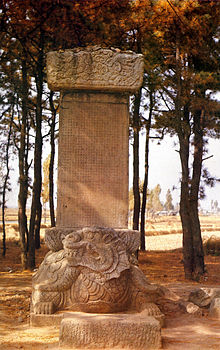36°56′42″N 127°7′57″E / 36.94500°N 127.13250°E / 36.94500; 127.13250
| Stele of Bongseon Honggyeongsa | |
 | |
| Korean name | |
|---|---|
| Hangul | 봉선홍경사사적갈비 |
| Hanja | 奉先弘慶寺事蹟碣碑 |
| Revised Romanization | Bongseon Honggyeongsa Sajeok Galbi |
| McCune–Reischauer | Pongsŏn Honggyŏngsa Sajŏk Kalbi |
The Stele of Bongseon Honggyeongsa Temple was designated as the seventh National Treasure of Korea on December 12, 1962.
The Bongseon Honggyeongsa Temple was built in 1021 during the reign of King Hyeonjong who built the temple in accordance with the wishes of his father King Anjong and because he was inspired by the Lotus Sutra. "Bongseon", which means "In Reverence of Father's Wishes”, was added to the name of the temple. The stele commemorates the construction of the temple which was set up in 1026 CE, five years after the temple was constructed. The stele is all that remains of the temple.
The inscription of the stele was composed by Choi Chung also known as Haedonggongja, one of the greatest Confucian scholars and writers during the Goryeo Dynasty, and the calligraphy, in semi-cursive style, was done by Baek Hyeonrye. The inscription describes the foundation of the temple.
The stone stele rests on a pedestal shaped like a tortoise. The dragon-heads of the pedestal are facing the side instead of the front, a style that has often been used in East Asian stele. The head is also carved with fin-like wings that give the head the impression of dynamism and motion. The body of the stele is capped with a stone that is rounded and shows a dragon in the clouds.
The stele is currently located in Seonghwan-eup, Cheonan City in South Chungcheong province.